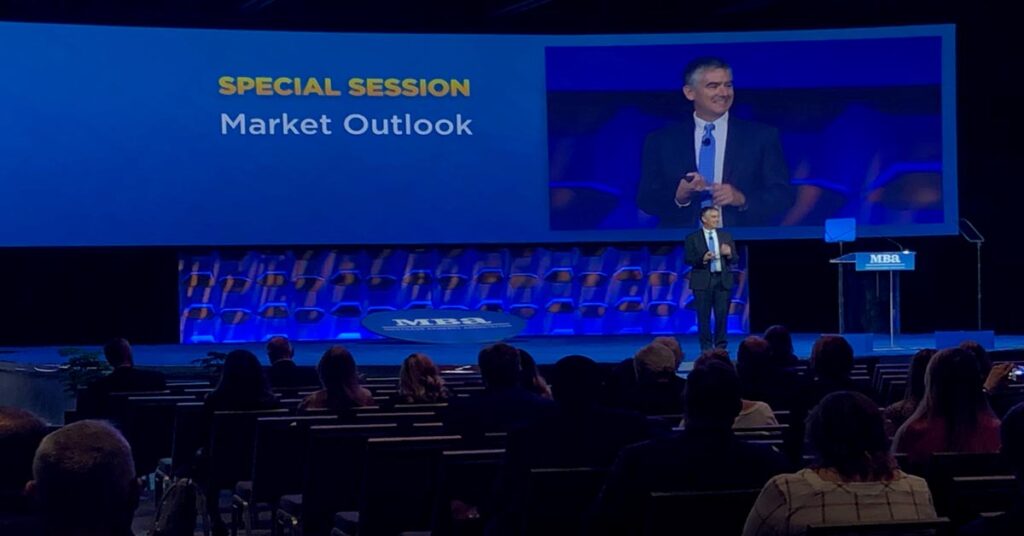A new forecast from the Mortgage Bankers Association (MBA) predicts that purchase mortgage originations will climb by 9% annually to reach a record volume of $1.73 trillion in 2022. This rise in purchase activity, however, will be accompanied by a sizable plunge in refinance originations, which the MBA projects to drop by a whopping 62% next year.
The trade group presented its 2022 outlook at its 2021 Annual Convention & Expo in San Diego, briefing an intrigued gathering of industry stakeholders about what to expect next year. The plummet in refinancing would bring refi originations to $860 billion in 2022, down from $2.26 trillion this year. Together, the forecast purchase growth and refi decline in 2022 would combine for an overall volume of $2.59 trillion in mortgage originations, a 33% drop from 2021.
Considering the record year the mortgage industry enjoyed in 2020 and the continued, although reduced, strength that has persisted through this year, the predicted results for 2022 would still constitute a strong year for the housing market, said Mike Fratantoni, MBA’s senior vice president and chief economist. He did caution mortgage professionals, however, to temper their expectations if they’re hoping for the banner heights of the past couple years.
“I already reminded you that 2020 had an all-time record total volume [of] $4.1 trillion,” Fratantoni said. “This year came in higher than we have expected. Rates stayed lower for longer. Refis kept coming in. Current estimate [for total originations] is $3.8 trillion for 2021. Next year, depending upon your point of view, one headline is an all-time record in terms of purchase volume at more than $1.7 trillion total — and we expect 2023 to be even higher at more than $1.8 trillion.
“But if you’re more focused … on that refi portion of the market, [there will be] a big, significant decline in the level of refi next year.”
If the MBA’s forecasts for this year and next come to fruition, the refi dive in 2022 would follow a smaller decline of 14% in 2021. Part of the anticipated decreases are due to the shrinking refi candidate pool. With rates remaining low over the past year and beyond, many borrowers have already opted to refinance their loans, leaving fewer to do so moving forward.
Get these articles in your inbox
Sign up for our daily newsletter
Get these articles in your inbox
Sign up for our daily newsletter
Another impact on refis moving forward is the projected rise of mortgage rates. The economy saw a robust, although weaker than expected, rebound in 2021, Fratantoni explained, but the downside of such growth is that inflation has picked up. It has accelerated quite a bit, with the MBA anticipating 5.3% inflation at the end of this year.
“And we don’t see us getting back to the Fed’s target of 2% for a couple of years,” Fratantoni said. “This is not a forecast of transitory inflation. This is a forecast of persistent inflation.”
Combined with the downwardly trending unemployment rate, heightened inflation should lead the Federal Reserve to begin tapering its asset purchases by the end of this year and to raise short-term interest rates by the end of 2022, moving the needle on mortgage rates as well. The MBA’s baseline forecast has average mortgage rates at 3.1% at the end of 2021 before climbing to 4.0% by the end of next year.
“Mortgage lenders and borrowers should expect rising mortgage rates over the next year, as stronger economic growth pushes Treasury yields higher,” Fratantoni said. “Robust homebuyer demand from millennial households, households seeking more space and still-low mortgage rates are favorable tailwinds for the housing market in 2022, and are behind MBA’s expectations of record purchase originations over the next two years.”
Fratantoni reiterated that, even with all the shifts ahead, 2022 looks to be another healthy year. And with the purchase market set to normalize a bit, the year ahead should bring some relief to many who have found themselves squeezed out of the scorching markets of 2020 and 2021.
“Homebuilders will have more success overcoming current building-material shortages and should be able to increase the pace of construction to meet the sizable demand for buying,” he said. “More newly built homes and more homeowners listing their homes for sale should lead to some deceleration in home-price growth next year. This is good news for the many would-be buyers who are currently priced out or delaying decisions because of low supply conditions and steep home-price appreciation.”




















































